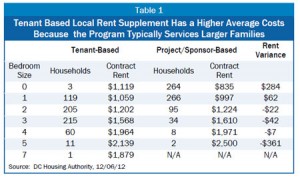Mayor Gray’s proposed FY 2014 budget includes significant investments in affordable housing in support of his goal of creating 10,000 net new units of affordable housing by 2020. Yet the new funds largely focus on construction and rehabilitation, meaning that most units will not come online until FY 2015. While affordable housing production is critical, there are tools that DC can deploy to help address some of DC’s significant affordable housing needs immediately.
One of those programs is DC’s tenant-based portion of the local rent supplement program. There are no funds in the proposed FY 2014 budget to expand this program, but the Council should find ways to do so when it completes work on next year’s budget.
The Local Rent Supplement Program (LRSP) was created in 2007 to make homes affordable to families with very low-incomes ‘ 30 percent of area median income or less, or roughly $32,000 for a family of four. It does this by providing rental assistance to bridge the gap between market rents and the rents that very low income families can afford to pay. LRSP was created in large part to address the limited and declining federal support for housing vouchers.
The program has three components; a tenant-based portion and a project-based and sponsor-based portion. Under project- and sponsor-based LRSP, subsidies are tied to specific housing units operated by a for-profit or non-profit developer or to a non-profit developer that commits to using the subsidy to provide affordable housing to its clients. Most of the subsidies go to newly built or renovated housing. The mayor’s proposed budget includes a $5 million increase to this portion of the program.
The tenant-based portion of the program goes to an individual family who can take the LRSP voucher and use it at any DC apartment that is under the fair market rent. Because it is not tied to production, tenant-based LRSP can be deployed quickly. 
The tenant based portion of the program has been criticized as being more costly than the project-sponsor based side, when the costs per program are broken out by bedroom size, there is little variance between the two programs (see Table 1). Tenant-based LRSP tends to serve larger families — 80 percent are two-bedroom units are larger, while 80 percent of the project/sponsor-based units serve residents that need one-bedroom units or efficiencies.
The program has also been criticized as creating long-term dependency on housing aid, yet this largely reflects the great mismatch between incomes and housing costs for residents living on low-wage work or public benefits ‘ such as social security, disability income, or public assistance. In DC, a single-parent family with two children would need to work full time, year round and earn $28.96 to afford the market rate rent for a two bedroom apartment. This is just under the median wage, or middle wage, for all jobs in DC which was $29.41 in 2011. That means close to half of all jobs in DC do not pay enough for someone to afford the market-rate rent for a two bedroom apartment and suggests that efforts to help low-income families improve their incomes is key to housing mobility.
Tenant-based LRSP helps ensure DC is able to serve the wide variety of families that need affordable housing assistance ‘ from residents with severe barriers to stable housing to residents who simply don’t earn enough from their low-wage job. For this reason, the DC budget needs to include increases for both tenant-based and project/sponsor-based LRSP.
To print a copy of today’s blog, click here.
